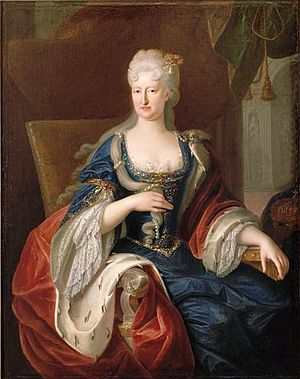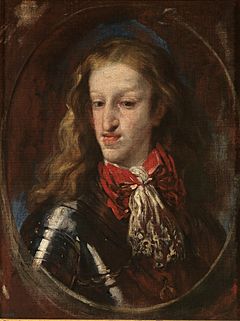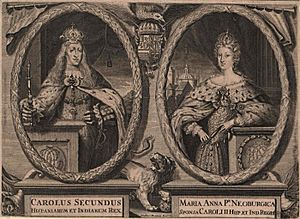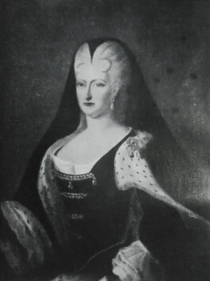Maria Anna of Neuburg facts for kids
Quick facts for kids Maria Anna of Neuburg |
|
|---|---|

Portrait by Robert Gabriel Gence
|
|
| Queen consort of Spain | |
| Tenure | 28 August 1689 – 1 November 1700 |
| Born | 28 October 1667 Benrath Palace, Düsseldorf, Electoral Palatinate |
| Died | 16 July 1740 (aged 72) Infantado Palace, Guadalajara, Spain |
| Burial | El Escorial, Spain |
| Spouse | |
| House | Wittelsbach |
| Father | Philip William, Elector Palatine |
| Mother | Elisabeth Amalie of Hesse-Darmstadt |
| Religion | Roman Catholicism |
Maria Anna of Neuburg (Spanish: Mariana) was a German princess born on October 28, 1667. She became the Queen consort of Spain in 1689. She was the second wife of Charles II, who was the last king from the House of Habsburg to rule Spain.
Her time as queen was mostly about a big political fight. Two groups, one supporting France and one supporting Austria, argued over who would become the next king of Spain. This disagreement eventually led to a major war called the War of the Spanish Succession, which lasted from 1701 to 1714. When King Charles II died in 1700, a French prince became the new king, and Maria Anna was sent away from Spain. She lived a quiet life and passed away in 1740.
Early Life and Marriage
Maria Anna was born on October 28, 1667, at Benrath Palace near Düsseldorf. She was the twelfth child of Philip William, who ruled the lands of Berg and Jülich. Her mother was Elisabeth Amalie of Hesse-Darmstadt.
Her family, the House of Wittelsbach, was known for having many children. This made Maria Anna and her sisters good choices for royal marriages. For example, her sister Maria Sophia married Peter II of Portugal. Another sister, Eleonore, became the third wife of Emperor Leopold. This meant Maria Anna was an aunt to future emperors, Joseph I and Charles VI.

In 1685, Maria Anna's father became the ruler of the Electoral_Palatinate. Soon after, in 1688, King Louis XIV of France claimed part of this land. French soldiers invaded and destroyed many towns, including much of Heidelberg. This destruction made Maria Anna strongly dislike France and favor Austria.
This strong anti-French feeling was a key reason she was chosen to marry Charles II of Spain. Charles's first wife had died in 1689, and he needed a new queen quickly to have an heir. His mother, Mariana of Austria, chose Maria Anna because her family was known for having many children and for being against France.
Maria Anna and Charles were married by a representative in August 1689. Their official wedding took place on May 14, 1690, in San Diego, near Valladolid. Their marriage was celebrated with big parties, especially in Naples.
Queen of Spain
When Maria Anna became Queen, the Spanish government was divided into two main groups. One group supported Austria, and the other supported France. The 'Austrian' group was mostly in charge during this time, and Maria Anna became their leader after Charles's mother died in 1696.
In 1690, the 'Austrian' group decided Spain should join the Nine Years War. This was a bad choice for Spain. The country ran out of money in 1692, and by 1696, France had taken over much of Catalonia.
Maria Anna's power as Queen came from the idea that she would give birth to the next king. However, it soon became clear that she likely wouldn't have children. To try and keep her power, she sometimes claimed to be pregnant. She also encouraged King Charles to try different treatments to help him have children. This made it seem like it wasn't her fault that there was no heir.
The Spanish Succession Problem
In 1698, King Charles II became very sick, and it looked like he might die soon. Britain, France, and the Netherlands signed a treaty to decide who would get parts of the Spanish Empire. They chose a six-year-old boy named Joseph Ferdinand of Bavaria to inherit most of it. The rest would be split between France and Austria. The Spanish people were not asked about this plan and did not like it.
On November 14, 1698, King Charles wrote his will. He named Joseph Ferdinand as his successor but said that the Spanish Empire should stay together as one. He also named Maria Anna as the person who would rule until Joseph Ferdinand was old enough.
However, Joseph Ferdinand died in 1699. So, France, Britain, and the Netherlands made another treaty in March 1700. This time, they chose Maria Anna's nephew, Archduke Charles, to be the heir. But they still planned to divide Spain's lands in Italy, the Netherlands, and Northern Spain among France, Savoy, and Austria.
King Charles changed his will again to favor Archduke Charles. But he still insisted that Spain should remain a single, independent country.
Most of the Spanish nobles, especially in Castile, wanted a French prince to be the next king. Maria Anna tried hard to make sure her nephew, Archduke Charles, would get the throne. In June 1700, her supporter, Mendoza, who was the head of the Inquisition, arrested the king's French-supporting priest. He accused the priest of using magic on the king. When the priest was found innocent, Mendoza arrested the people who had cleared him. This made Maria Anna look bad, as many thought she was behind it.
King Charles became very ill again in late 1700. By September 28, he could no longer eat. A powerful cardinal named Portocarrero convinced the king to change his will one last time. This time, the will named Philip of Anjou, the grandson of King Louis XIV of France, as the next king.
King Charles II died on November 1, 1700. Philip was declared the new King of Spain on November 16, with Portocarrero as his main advisor. Maria Anna was sent away to Toledo, where she lived quietly until 1706. Later, King Philip sent her to Bayonne in France, where she lived for many years. Some stories say she even married a local barrel-maker there.
In 1739, she was allowed to return to Spain and lived in the Palacio del Infantado, Guadalajara. She died on July 16, 1740, and was buried in the El Escorial Monastery.
Heraldry
- Heraldry of Maria Anna of Neuburg
See also
 In Spanish: Mariana de Neoburgo para niños
In Spanish: Mariana de Neoburgo para niños
|
Maria Anna of Neuburg
Born: 28 October 1667 Died: 16 July 1740 |
||
| Spanish royalty | ||
|---|---|---|
| Vacant
Title last held by
Marie Louise d'Orléans |
Queen consort of Spain 1690– 1700 |
Vacant
Title next held by
Maria Luisa of Savoy |






